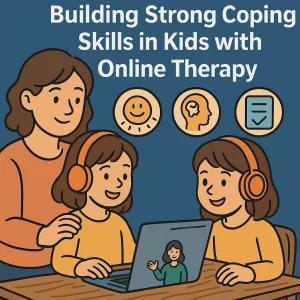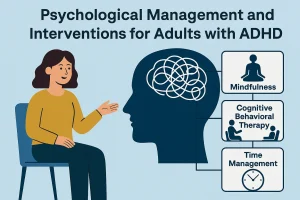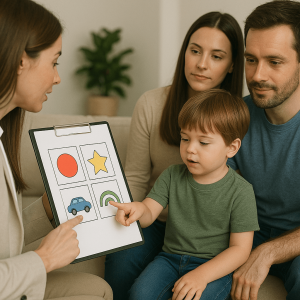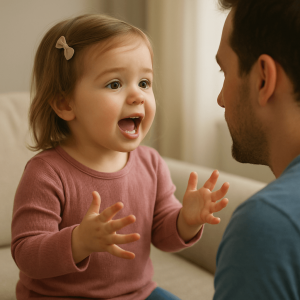Effective Strategies to Teach Emotional Regulation in Schools
Last Updated: January 10, 2025
Emotional regulation in school is the ability to manage and respond to emotions in a healthy way. For students, this means recognizing feelings like frustration, excitement, or anxiety and knowing how to deal with them, whether it’s taking deep breaths, talking about their feelings, or finding ways to calm down. Think of it like a toolbox for handling emotions—it helps kids keep their cool, stay focused, and react thoughtfully rather than impulsively, creating a positive and productive learning environment.
Teaching emotional regulation in schools is more than just a nice-to-have; it’s essential. It’s about giving students the skills they need to navigate their emotions and the ups and downs of daily life. When kids can regulate their emotions, they’re better equipped to face challenges, solve problems, and build strong relationships with their peers. In other words, emotional regulation sets the foundation for both personal and academic success.
Why It Matters in Schools
You might be wondering, why should schools prioritize emotional regulation? The answer is simple: emotional regulation plays a big role in how well students perform in school and beyond. When students understand their emotions and know how to manage them, they can stay focused in class, participate more actively, and handle stress or setbacks more effectively. It’s not just about getting good grades; it’s about creating a positive learning environment where students feel safe, supported, and ready to learn.
Why Teach Emotional Regulation in Schools?
Teaching emotional regulation in schools is not just about helping students feel good—it’s about setting them up for success in all areas of their lives. Let’s explore how emotional regulation makes a big difference in learning, social skills, and classroom behavior.
Better Learning
When students can manage their emotions, they’re better able to stay focused on their work, which directly impacts their academic performance. Imagine trying to solve a math problem while feeling anxious or frustrated; it’s not easy! Emotional regulation gives students the tools to calm their minds, which helps them concentrate better during lessons and exams. This focus leads to improved grades and a more positive attitude towards learning. By mastering emotional regulation, students learn to push past distractions and keep their attention where it needs to be—on their studies.
Improved Social Skills
School is more than just academics; it’s also a place where students learn to interact with others. Emotional regulation in school plays a key role in helping students get along with their peers and build meaningful relationships. When kids understand their own emotions, they’re better equipped to understand others, leading to more empathy and cooperation. Instead of reacting impulsively, they learn to pause, think, and respond in ways that are considerate and constructive. This not only helps in making friends but also in working together on group projects, resolving conflicts, and creating a more supportive school community.
Fewer Behavioral Issues
Classrooms can be challenging environments, especially when students struggle with managing their emotions. Outbursts, disruptions, and conflicts can make it hard for everyone to focus on learning. Teaching emotional regulation helps reduce these issues by equipping students with the skills to handle their emotions in healthier ways. When students can regulate their emotions, they’re less likely to act out, and more likely to find calm solutions to their problems. This creates a more peaceful classroom environment, where teachers can spend less time managing behavior and more time teaching.
Also Read: Online Behavioral Therapy: A Guide to What to Expect
How Schools Can Teach Emotional Regulation
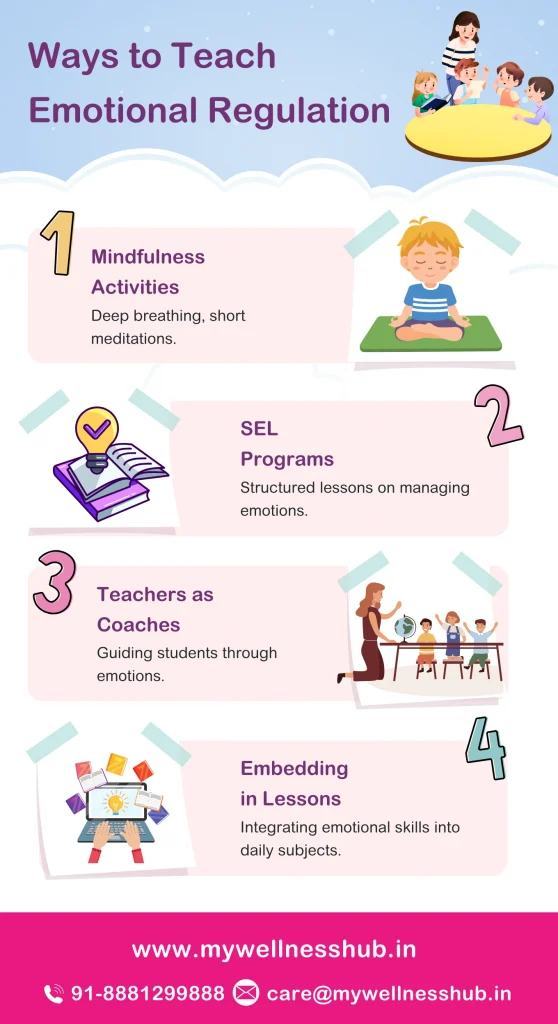
Teaching emotional regulation in schools doesn’t have to be complicated. With a few simple strategies, schools can help students learn how to manage their emotions effectively. Here are practical ways to make emotional regulation part of everyday learning.
1. Mindfulness Activities
Mindfulness helps students calm their minds and focus. Activities like deep breathing, short meditations, or listening exercises teach students to notice their emotions without feeling overwhelmed.
- Example: Start the day with a breathing exercise to set a calm tone.
- Why It Works: Regular mindfulness helps students pause and reflect before reacting, making it easier to focus in class.
2. Social-Emotional Learning (SEL) Programs
SEL programs teach students about emotions, empathy, and building relationships through fun and interactive lessons.
- Activities Include: Role-playing, group discussions, and goal-setting exercises.
- Why It Works: SEL builds resilience, improves social skills, and helps students make better decisions.
3. Teachers as Emotion Coaches
Teachers can guide students by modeling how to handle emotions and offering support during tough moments.
- Example: When a student is upset, the teacher can help them name their feeling, talk about what caused it, and find ways to manage it.
- Why It Works: This hands-on approach makes students feel supported and teaches them practical emotional skills.
4. Including Emotional Regulation in Lessons
Emotional regulation can be part of everyday learning, not just a separate activity.
- Why It Works: It shows students that managing emotions is a skill they can use in all areas of life.
- Example: Discuss how characters in a story handle their emotions or explore how feelings affect decision-making in science or social studies.
Challenges and Solutions
While integrating emotional regulation into schools is highly beneficial, it’s not without its challenges. Many educators and administrators face obstacles that can make it difficult to implement these practices consistently. However, with the right approach, these challenges can be overcome. Let’s look at some common hurdles and practical solutions that can help schools successfully teach emotional regulation.
Common Challenges
Lack of Time:
One of the biggest challenges schools face is finding the time to incorporate emotional regulation into the already packed school day. Teachers often feel pressured to cover the curriculum, leaving little room for additional activities like mindfulness or SEL (Social-Emotional Learning) lessons.
Limited Resources:
Schools may struggle with limited resources, such as a lack of access to appropriate materials, apps, or training. Without the right tools, it can be hard for teachers to effectively teach emotional regulation skills.
Lack of Support:
Another common issue is the lack of support from parents, other teachers, or school administration. Without a shared commitment to prioritizing emotional regulation, efforts can feel fragmented and less effective.
Easy Fixes
Start Small:
Instead of changing the whole curriculum, add short activities like breathing exercises or quick discussions about emotions to daily lessons. Just a few minutes a day can make a big difference. For example, start each class with a calming exercise to set the tone.
Get Parents Involved:
Share simple strategies with parents so they can help at home. Send tips or hold workshops to teach parents how to support their kids. A consistent approach between home and school helps students practice and grow these skills.
Build a Supportive Culture:
Create an environment where teachers, parents, and students openly talk about emotions. Train teachers to feel confident in teaching and modeling emotional regulation. A supportive school community ensures these skills become a natural part of daily life.
Know more about Emotional Regulation in Kids: Causes and Developmental Stages
Tips for Success
Be Consistent:
- Regularly include emotional regulation activities in the daily routine, such as breathing exercises, mindfulness sessions, or emotion-focused discussions.
- Reinforce the importance of emotional regulation by practicing it consistently, making it a natural part of the school day.
- Encourage students to use these skills during stressful moments or conflicts, reinforcing their value.
Involve Parents:
- Share simple strategies with parents to use at home, like deep breathing or discussing emotions after challenging situations.
- Host workshops or send home resources to create a consistent approach between school and home.
- Encourage parents to reinforce the same emotional regulation messages, enhancing skill development.
Track Progress:
- Use simple tools like regular check-ins, self-reflection journals, or emotion charts to monitor students’ emotional growth.
- Observe classroom behavior and gather feedback during activities to identify areas for improvement.
- Celebrate progress and use structured assessments, like SEL surveys, to guide targeted support for students who need extra help.
Read more about on Emotional Regulation for Kids: Easy Tips and Activities
Conclusion
Teaching emotional regulation in schools is essential for helping students focus, manage their feelings, and build better relationships. These skills boost academic success and prepare kids for life’s challenges. Simple steps like mindfulness activities, SEL programs, and teacher support can make a big difference. Schools don’t need big budgets to start—small, consistent efforts and involving parents go a long way. Explore tools like those on Wellness Hub to get started. Together, educators and parents can create a positive impact, giving students the skills they need to thrive. Let’s build brighter futures by making emotional regulation part of every school day!
Frequently Asked Questions:
1. What is emotional regulation, and why is it important in schools?
Emotional regulation is the ability to manage and respond to emotions in a healthy way. In schools, it helps students stay focused, manage stress, build better relationships, and improve overall learning outcomes.
2. How can schools teach emotional regulation to students?
Schools can teach emotional regulation through mindfulness activities, Social-Emotional Learning (SEL) programs, involving teachers as emotion coaches, and embedding emotional skills into everyday lessons.
3. What are some simple mindfulness activities for students?
Simple mindfulness activities for students include deep breathing exercises, short meditations, and mindful listening. These activities help students become aware of their emotions and manage them effectively.
4. What are the benefits of Social-Emotional Learning (SEL) programs in schools?
SEL programs teach students how to manage emotions, set goals, show empathy, and build healthy relationships. These programs provide a structured way to help students improve their emotional regulation skills and overall behavior.
5. How can teachers support emotional regulation in the classroom?
Teachers can support emotional regulation by acting as coaches, modeling healthy emotional responses, guiding students through their emotions, and creating a classroom environment that encourages open discussions about feelings.
6. How can schools teach emotional regulation with limited resources?
Schools can start with simple activities like deep breathing exercises, short meditations, or classroom talks about emotions. Free or affordable programs like SEL (Social-Emotional Learning) can also help. Platforms like Wellness Hub offer easy-to-use tools and tips to get started. Start small, be consistent, and watch the impact grow!
7. What are common challenges schools face when teaching emotional regulation?
Common challenges include a lack of time, limited resources, and insufficient support from parents or other school staff. However, these can be addressed by starting small, using available resources, and involving parents in the process.
8. How can parents help support emotional regulation at home?
Parents can support emotional regulation by encouraging their children to practice mindfulness, discussing feelings openly, and using simple techniques like deep breathing when emotions run high. Schools can also provide parents with tips and resources to reinforce these skills at home.
9. How can schools track progress in emotional regulation?
Schools can track progress through simple methods like check-ins, self-reflection journals, emotion charts, and SEL assessment surveys. Regular feedback from teachers can also help monitor how well students are developing their emotional regulation skills.
10. Why should schools prioritize teaching emotional regulation?
Prioritizing emotional regulation helps create a positive learning environment, reduces behavioral issues, and equips students with lifelong skills to handle stress, build relationships, and succeed in various aspects of life.
About Author:
Lasya Vooturi,
Clinical Psychologist (A) & Behavioral Therapist
Lasya holds a Professional Diploma in Clinical Psychology from Amity University, where she deepened her understanding of psychological principles from March 2023 to March 2024. With over a year of dedicated experience as a Behavioral Therapist, Lasya has honed her skills in applying effective therapy techniques tailored to individual needs. Fluent in Telugu, Hindi, and English, she is adept at connecting with a diverse range of clients, ensuring comprehensive communication and understanding. Lasya’s approach is grounded in empathy and scientific rigor, making her a trusted ally in navigating mental health challenges.
Book your Free Consultation Today
Parent/Caregiver Info:
Client’s Details:
* Error Message
